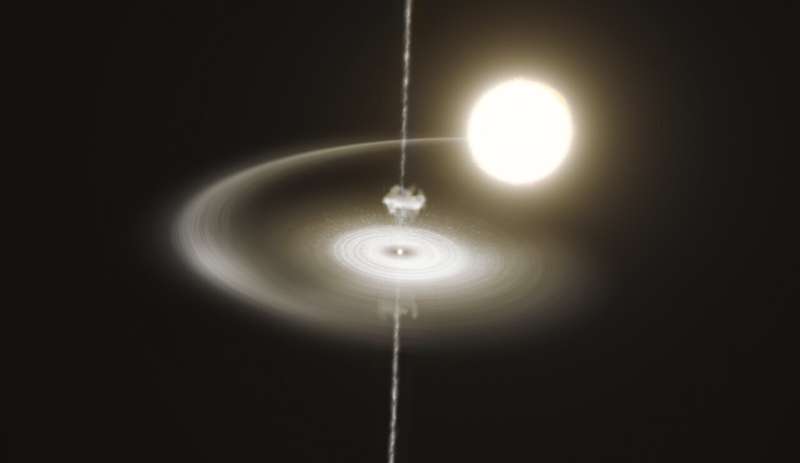This article has been reviewed according to Science X's editorial process and policies. Editors have highlighted the following attributes while ensuring the content's credibility:
fact-checked
peer-reviewed publication
trusted source
proofread
European Southern Observatory telescopes help unravel pulsar puzzle

With a remarkable observational campaign that involved 12 telescopes both on the ground and in space, including three European Southern Observatory (ESO) facilities, astronomers have uncovered the strange behavior of a pulsar, a super-fast-spinning dead star.
This mysterious object is known to switch between two brightness modes almost constantly, something that until now has been an enigma. But astronomers have now found that sudden ejections of matter from the pulsar over very short periods are responsible for the peculiar switches.
"We have witnessed extraordinary cosmic events where enormous amounts of matter, similar to cosmic cannonballs, are launched into space within a very brief time span of tens of seconds from a small, dense celestial object rotating at incredibly high speeds," says Maria Cristina Baglio, researcher at New York University Abu Dhabi, affiliated with the Italian National Institute for Astrophysics (INAF), and the lead author of the paper published in Astronomy & Astrophysics.
A pulsar is a fast-rotating, magnetic, dead star that emits a beam of electromagnetic radiation into space. As it rotates, this beam sweeps across the cosmos—much like a lighthouse beam scanning its surroundings—and is detected by astronomers as it intersects the line of sight to Earth. This makes the star appear to pulse in brightness as seen from our planet.
PSR J1023+0038, or J1023 for short, is a special type of pulsar with a bizarre behavior. Located about 4,500 light years away in the Sextans constellation, it closely orbits another star. Over the past decade, the pulsar has been actively pulling matter off this companion, which accumulates in a disk around the pulsar and slowly falls towards it.
Since this process of accumulating matter began, the sweeping beam virtually vanished and the pulsar started incessantly switching between two modes. In the 'high' mode, the pulsar gives off bright X-rays, ultraviolet and visible light, while in the 'low' mode it's dimmer at these frequencies and emits more radio waves. The pulsar can stay in each mode for several seconds or minutes, and then switch to the other mode in just a few seconds. This switching has thus far puzzled astronomers.
"Our unprecedented observing campaign to understand this pulsar's behavior involved a dozen cutting-edge ground-based and space-borne telescopes," says Francesco Coti Zelati, a researcher at the Institute of Space Sciences, Barcelona, Spain, and co-lead author of the paper.
The campaign included ESO's Very Large Telescope (VLT) and ESO's New Technology Telescope (NTT), which detected visible and near-infrared light, as well as the Atacama Large Millimeter/submillimeter Array (ALMA), in which ESO is a partner. Over two nights in June 2021, they observed the system make over 280 switches between its high and low modes.
"We have discovered that the mode switching stems from an intricate interplay between the pulsar wind, a flow of high-energy particles blowing away from the pulsar, and matter flowing towards the pulsar," says Coti Zelati, who is also affiliated with INAF.
In the low mode, matter flowing towards the pulsar is expelled in a narrow jet perpendicular to the disk. Gradually, this matter accumulates closer and closer to the pulsar and, as this happens, it is hit by the wind blowing from the pulsating star, causing the matter to heat up. The system is now in a high mode, glowing brightly in the X-ray, ultraviolet and visible light. Eventually, blobs of this hot matter are removed by the pulsar via the jet. With less hot matter in the disk, the system glows less brightly, switching back into the low mode.
While this discovery has unlocked the mystery of J1023's strange behavior, astronomers still have much to learn from studying this unique system and ESO's telescopes will continue to help astronomers observe this peculiar pulsar. In particular, ESO's Extremely Large Telescope (ELT), currently under construction in Chile, will offer an unprecedented view of J1023's switching mechanisms.
"The ELT will allow us to gain key insights into how the abundance, distribution, dynamics, and energetics of the inflowing matter around the pulsar are affected by the mode switching behavior," concludes Sergio Campana, Research Director at the INAF Brera Observatory and co-author of the study.
More information: M.C. Baglio et al, Matter ejections behind the highs and lows of the transitional millisecond pulsar PSRJ1023+0038, Astronomy & Astrophysics (2023). DOI: 10.1051/0004-6361/202346418
Journal information: Astronomy & Astrophysics
Provided by ESO


















